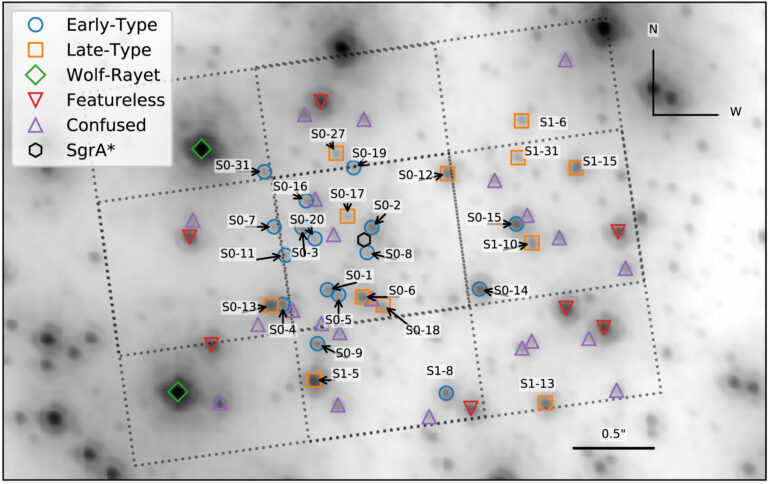Stars living closest to the supermassive black hole at the center of the Milky Way have no stellar companions, a new study finds.
Using W. M. Keck Observatory on Maunakea, Hawaiʻi Island, Devin Chu of Hilo, an astronomer with the UCLA Galactic Center Orbits Initiative, led a 10-year survey that found these “S-stars,” where “S” stands for Sagittarius A*, the name of the monster black hole at our galaxy’s core, are all single.
The result is surprising given the S-stars Chu’s team observed included young, massive main-sequence stars that are only about six million years old. Normally, stars at this age that are 10 times more massive than our Sun spend their childhood years paired with a twin in a binary system, or sometimes even as triplets.
“This discovery speaks to the incredibly interesting environment of the Galactic Center,” said Chu, who is the lead author of the study published in today’s issue of The Astrophysical Journal. “It is likely the supermassive black hole’s powerful influence causes binary star systems to either merge or become disrupted, where a companion star gets kicked out from the region. This may explain why we don’t see any stars with partners so close to Sagittarius A*.”
The decade-long survey marks the first systematic search for binary systems within the S-star cluster.
Using Keck Observatory’s adaptive optics system paired with its OH-Suppressing Infrared Imaging Spectrograph (OSIRIS), Chu and his team tracked the motions of 28 S-stars; 16 of which are young, main-sequence B-type stars and the rest are low-mass, old M-type and K-type giant stars.
“Keck’s adaptive optics and OSIRIS have been crucial in providing us the infrared insight we needed to peer through the Galactic Center dust as well as distinguish the individual S-stars in this very crowded region,” said Chu.
Not only did they find the S-stars flying solo, the researchers were also able to calculate the limit on how many of these S-stars could exist as binaries, a metric known as the binary fraction. They discovered the young S-star binary fraction limit is 47 percent, meaning for every 100 S-stars, a maximum of 47 of them could be in binary systems. This limit is dramatically lower than what is expected for similar types of young stars in Earth’s solar neighborhood, which have a binary fraction of 70 percent.
The finding suggests stars with companions have a difficult time staying together in the extreme environment of the Milky Way’s supermassive black hole.
The discovery adds to the already exotic nature of S-stars, whose births remain a mystery. A black hole’s tidal forces typically disrupt traditional star formation, raising questions as to how S-stars managed to develop within the dangerous cosmic whirlpool Sagittarius A* creates.
“I’m so grateful to have the opportunity to study these bizarre and fascinating stars from my home island,” said Chu. “Some of the data used for this survey was taken while I was a student at Hilo Intermediate and High School! It feels incredibly rewarding to be able to conduct groundbreaking science while returning home to Hawaiʻi.”
More information:
Devin S. Chu et al, Evidence of a Decreased Binary Fraction for Massive Stars within 20 milliparsecs of the Supermassive Black Hole at the Galactic Center, The Astrophysical Journal (2023). DOI: 10.3847/1538-4357/acc93e
Provided by
W. M. Keck Observatory
Citation:
A strange, solitary life for young stars at the Milky Way’s center (2023, May 11)



